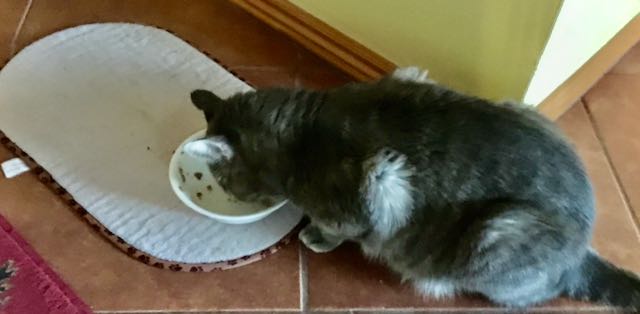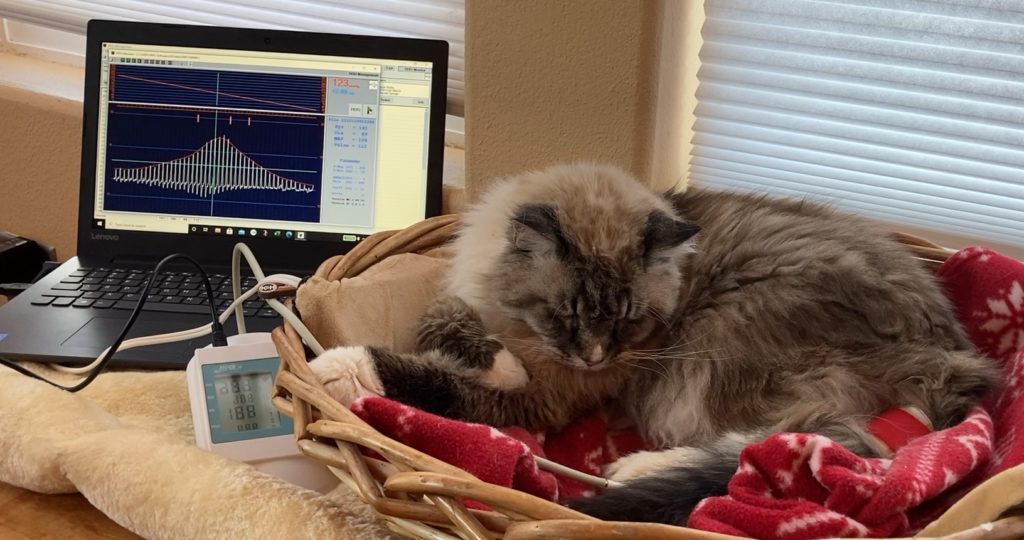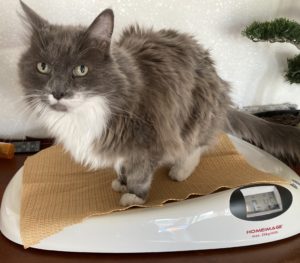
Diet is a key therapy for cats with chronic kidney disease (CKD). Diets for managing CKD in cats aim to (Reference 1):
- lessen the clinical signs of CKD
- slow the progression of the disease
- provide adequate nutrition
Diets for managing ckd in cats
The goal of diets for managing CKD in cats is to reduce the amount of uremic waste products while providing adequate nutrition. There are a number of commercially available diets that are formulated to do this. These foods feature (Reference 1):
- reduced phosphorus
- restricted amounts of high-quality protein
- higher calories
- reduced sodium
- potassium supplementation
- B vitamins and fatty acids
Phosphorus
Phosphorus is needed for the growth, maintenance, and repair of all tissues and cells, and for the production of the genetic building blocks, DNA and RNA. Phosphorus is also needed to help balance and use other vitamins and minerals, including vitamin D, iodine, magnesium, and zinc (Reference 2).
As kidney disease progresses, the ability of the kidneys to excrete phosphorus declines. To reduce stress on the kidneys, diets for managing CKD in cats aim to reduce the amount of phosphorus and balance the ratio of calcium to phosphorus. Too much phosphorus and not enough calcium can lead to kidney and bone damage (Reference 1). Commercial kidney diets are formulated to maintain an appropriate ratio of calcium to phosphorus.
protein in diets for managing cats with ckd
Since protein contributes significantly to phosphorus content, kidney diets restrict the amount of protein. Less protein means less uremic waste products. Emphasis is placed on formulating these diets with “high quality” protein. High quality proteins are a “complete package” and provide the cat with all the amino acids he or she needs. Thus, the protein used is highly bioavailable and generates less uremic waste products (Reference 1).
There are concerns that reduced protein diets predispose cats to weight loss and loss of lean muscle mass. Some recent studies suggest that senior cats may require more protein than younger cats to maintain lean body mass (LBM) (Reference 1).
Some practitioners advocate feeding higher protein diets to cats suffering with CKD to maintain the LBM. This may not be the answer to maintain LBM – increased protein in the cat’s diet means more uremic waste, making the cat feel nauseated and not inclined to eat. Ultimately, the cat will be eating less and calorie reduction will lead to muscle wasting as the cat’s body uses his own muscles for nutrition (Reference 3).
More on Lean Body Mass…
A recent study in 2019 (Reference 4) found a correlation between consumption of essential amino acids (essential amino acids must be consumed in the diet) and LBM. Cats with CKD Stages 1 and 2 were fed either a control kidney diet or a higher calorie “test” kidney diet that included higher amounts of essential amino acids and carnitine, an amino acid derivative that plays a role in energy production in the body.
The cats eating the lower calorie control diet lost LBM whereas the other group of cats eating the “test” diet maintained their LBM. Researchers observed that the cats on the control diet did not eat enough food to get adequate amounts of essential amino acids. They found that essential amino acid intake, not total dietary protein, correlated with maintaining LBM.
Although offering reduced protein, most commercial kidney diets make sure that more than sufficient amounts of the essential amino acids are available. The challenge is to get cats with CKD to eat enough of the diets.
Other Supplements
Commercial diets for managing CKD in cats also supplement:
- Potassium, an electrolyte essential to the function of muscles and nerves
- B vitamins – these water soluble vitamins can be depleted as the cat drinks more water and urinates more
- Fatty acids – fatty acids found in fish oils are thought to reduce inflammation and decrease protein in the urine
Starting a kidney Diet
Renal diets are typically recommended for cats in IRIS Stages 2, 3, and 4. Occasionally a reduced protein diet may be prescribed for a Stage 1 cat who has persistent protein in her urine. Many practitioners like to introduce therapeutic diets when the cat is in IRIS Stage 2, because the cat should still be feeling well and more likely to accept the new diet (Reference 3).
The best time to switch to a kidney diet is when your cat is eating her regular cat food well and is feeling well. Wait to introduce the new diet if…
- Your cat has just come back from the hospital
- You have visitors or are doing home remodeling
- Your cat is not eating her regular food well
- Your cat is vomiting or having diarrhea
Introduce the new diet gradually, over several weeks (Reference 1)
Week 1 | Week 2 | Week 3 | Week 4 |
Offer 25% of the new diet and 75% of the current food | Offer 50% of the new diet and 50% of the current food | Offer 75% of new diet and 25% of the current food | Offer 100% of the new diet |
Make sure to offer the appropriate amount of calories to your cat – the new renal diet will most likely be more caloric than the your cat’s current food and you will not need to feed as much.
tips for transitioning to a kidney diet
- Choose a food similar to the one your cat is eating already – wet or dry? fish or chicken?
- Offer the new food in a separate bowl alongside the regular food
- Make sure to offer fresh food
- Use a “topper” to encourage your cat to try the new food – fish flakes or a favorite treat
- Try gently warming wet foods – the stronger smell may make the food more appealing
- Meal feed your cat – small, frequent meals gives your cat more chances to try the new food
- Avoid mixing medications into the new food – use a small amount of another food or pureed treat to give the medications
from “Helping Your Cat Transition to a Therapeutic Kidney Food”, Hill’s Pet Nutrition/Clinician’s Brief, Educational Concepts, LLC © 2022
If you are struggling with a finicky cat, talk to your vet. If your cat is healthy, ask if you can do a trial of mirataz to stimulate his appetite and facilitate the transition to the new food.
Alternatives to a commercial kidney diet
- Use a phosphorus binder in the food your cat will eat. Consult your veterinarian for the appropriate dose.
- Home cooked diets are an option but should be formulated by a veterinary nutritionist. Nutritionists affiliated with websites such as balance.it will work with your vet to formulate a recipe for your cat.
Studies have shown that diets for managing CKD in cats can increase longevity, help control uremia and maintain phosphorus concentrations. While some have concerns about the protein restriction in these diets, kidney diets have been shown to maintain LBM providing the cat eats enough food to get sufficient nutrition.
New research is focusing on the connection between the kidneys and the GI tract, particularly the uremic toxins that originate in the gut. Prebiotic and probiotic treatments in CKD cats are being investigated to see if improving the health of the microorganisms living in the gut can reduce blood concentrations of gut-derived uremic toxins. (Reference 5)
references
- Quimby, J. and Ross, S., Diets for Cats with Chronic Kidney Disease (CKD) [updated 2022]. http://www.iris-kidney.com/education/protein_restriction_feline_ckd.html [viewed 9/2023]
- Phosphorus: Fact Sheet for Health Professionals, https://ods.od.nih.gov/factsheets/Phosphorus-HealthProfessional/, viewed 9/2023.
- Cave, N. and Wall, M. Protein restriction for cats with chronic kidney disease, Vet Focus, Issue # 30.1, © 6/25/20
- Hall JA, Fritsch DA, Jewell DE, Burris PA, Gross KL. Cats with IRIS stage 1 and 2 chronic kidney disease maintain body weight and lean muscle mass when fed food having increased caloric density, and enhanced concentrations of carnitine and essential amino acids. Vet Rec. 2019 Feb 9;184(6):190. doi: 10.1136/vr.104865. Epub 2018 Dec 4. PMID: 30514741; PMCID: PMC6589452.
- Summers, S. and Quimby, J., The feline gut-kidney axis: food for thought, Veterinary Focus, Issue #33.1, 5/31/23, https://vetfocus.royalcanin.com/en/scientific/the-feline-gut-kidney-axis-food-for-thought, viewed 9/2023



